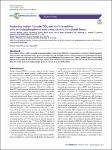Item Infomation
Full metadata record
| DC Field | Value | Language |
|---|---|---|
| dc.contributor.author | Marvin, Jessica | - |
| dc.contributor.author | Nicholson, James | - |
| dc.contributor.author | Turek, Cedar | - |
| dc.date.accessioned | 2023-08-18T07:05:29Z | - |
| dc.date.available | 2023-08-18T07:05:29Z | - |
| dc.date.issued | 2023 | - |
| dc.identifier.uri | https://link.springer.com/article/10.1557/s43579-023-00425-3 | - |
| dc.identifier.uri | https://dlib.phenikaa-uni.edu.vn/handle/PNK/8843 | - |
| dc.description | CC-BY | vi |
| dc.description.abstract | Barium titanate (BTO) is a widely researched ferroelectric useful for energy storage. While BTO’s surface chemistry is commonly studied using density functional theory, little has been published on the TiO2 surface. Here, we determined that BTO’s surface response can be decoupled from the ferroelectric response by using a pre-optimized ferroelectric slab and allowing only the top three atomic z-layers to respond to ligand binding. Multiple favorable binding modes were identified for hydrogen, hydroxyl, water, and tert-butyl phosphonic acid on BTO’s TiO2 surface. Of these ligands, tBuPA dominates surface binding with binding energies as low as − 2.61 eV for its nine configurations. | vi |
| dc.language.iso | en | vi |
| dc.publisher | Springer | vi |
| dc.subject | BTO | vi |
| dc.subject | TiO2 surface | vi |
| dc.title | Analyzing barium titanate TiO2 surface interactions with tert-butylphosphonic acid using density functional theory | vi |
| dc.type | Book | vi |
| Appears in Collections | ||
| OER - Khoa học Vật liệu, Ứng dụng | ||
Files in This Item:

